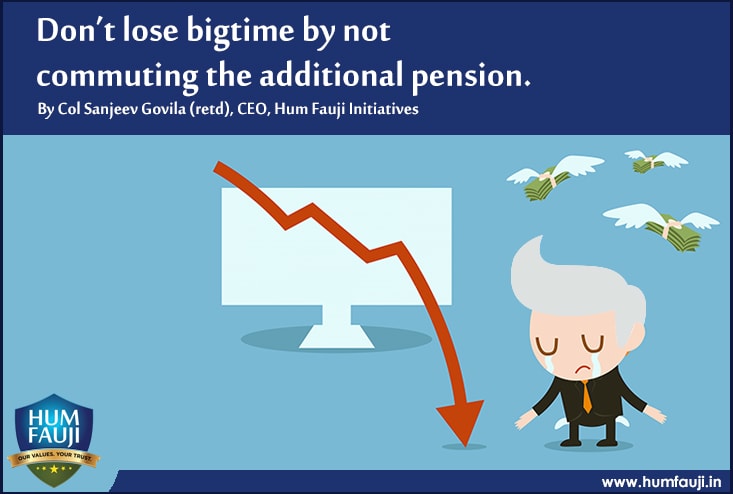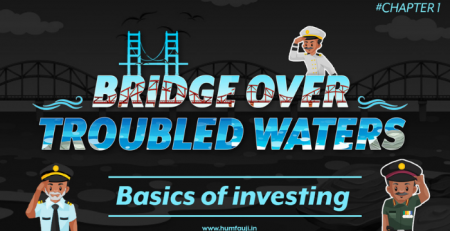Embarking on the journey toward retirement is a significant life transition, and like any great endeavor, it requires thoughtful planning and meticulous execution. As officers of the Indian Army, the path to retirement bliss is a unique and nuanced one, demanding a strategic approach that combines foresight, financial acumen, and a proactive mindset.
This four-part series aims to demystify the road to retirement bliss for Indian Armed Forces Officers. By combining proactive planning with strategic execution, officers can navigate this transformative phase with confidence, ensuring that retirement becomes a chapter of fulfillment, security, and enduring joy.
Part 1 – Understanding the Importance of Proactive Planning
In the first part of this comprehensive guide, I delve into why proactive planning is paramount and why it should commence approximately two years before retirement. The significance lies not only in the financial realm but also in the holistic preparation for a life beyond the uniform. I explore the actionable steps that should be taken during this critical period—actions that encompass financial assessments, skill-building, and mental preparedness for the upcoming transition.
Part 2 – Setting the Stage with Retirement Goals
Part two unveils the importance of setting specific retirement goals and the kinds of objectives one should aim for. Retirement is not a destination but a new chapter filled with aspirations. This section elucidates the process of envisioning a post-service life and strategically planning to achieve those aspirations. I guide you through the steps of aligning your financial resources with your dreams, ensuring that your retirement goals become a tangible and fulfilling reality.
Part 3 – Navigating the Investment Landscape
As retirement approaches, officers receive a substantial retirement corpus and the initiation of a pension. In the third part, I navigate the intricate landscape of investment instruments available, providing insights into prudent investment strategies, shedding light on diversified portfolios, risk management, and the art of making informed financial decisions. Deciphering the myriad options ensures that the hard-earned wealth is maximized for a secure and prosperous retired life.
Part 4 – Meeting Financial Goals for a Golden Retirement
In the final part of our guide, I explore how to meet your financial goals and craft a golden retirement. This involves creating a comprehensive budget, wisely utilizing the retirement corpus, exploring supplementary income opportunities, and reviewing the investment portfolio regularly. Additionally, I emphasize the importance of adequate insurance coverage and delve into the realm of estate planning for a legacy that endures.
Part 1: Setting Sail for Retirement Freedom – Why Start Proactive Planning 2 Years in Advance?
Retirement planning is a pivotal step in securing a financially stable future. However, diving into this process can be daunting. Let’s revamp our approach, making it not only informative but engaging for armed forces officers.
- Navigating the Financial Seas: Imagine retirement planning as a navigational journey. Two years before the retirement horizon, take stock of your financial seascape. Chart your assets, navigate through liabilities, and understand the intricacies of your pension. This initial step serves as the compass for your financial voyage.
- Plotting Aspirations on the Treasure Map: Retirement isn’t just about finances; it’s about dreams and aspirations. Picture your goals as points on a treasure map. Identify post-retirement desires, estimate associated costs, and plot them on your map whether it’s travel, hobbies, or family support. This visualization transforms your financial roadmap into a personalized adventure.
- Health Heroes- Shielding Your Financial Well-being: Health is your financial ship; keeping it seaworthy ensures a smoother voyage into retirement. Conduct health check-ups, review insurance policies including life and property protection, and estimate future healthcare expenses beyond the ECHS, if any. Adequate coverage ensures financial security in the face of unforeseen medical challenges.
- Debt-Free Sails: Clear your financial decks by addressing outstanding debts. Imagine debt repayment as hoisting the sails; it propels you forward with financial momentum. A debt-free ship navigates retirement waters more efficiently. Prioritize debt repayment to enter retirement with a clean slate if financially viable and feasible, fostering financial stability.
- Skills as Wind in Your Sails: Skill development is the wind in your financial sails. Invest time in enhancing existing skills or acquiring new ones. These skills may contribute to a post-retirement career or be the winds that push you towards passionate pursuits. Waiting for planning it at the time of retirement, or worse still, after retirement, is a strategy which will most likely fail, unless one is very lucky.
- Financial Advisors – Your Trusted Navigators: Engage with financial advisors specialized in armed forces retirement planning. They’re like seasoned navigators, guiding your financial ship through uncharted waters.
- Emergency Fund – Your Financial Lifeboat: Prepare for unforeseen storms with an emergency fund. Just as a lifeboat ensures safety at sea, an emergency fund provides financial security during unexpected challenges. Please be careful – too large an emergency fund is as undesirable as a too small one.
- Legal Lighthouses – Guiding Smooth Transitions: Ensure all legal documents are like lighthouses, guiding your transition. Wills, nominations, and other legal aspects must be up-to-date. Clear documentation ensures a smoother transition for your loved ones.
- Execution Blueprint – Your Roadmap to Financial Freedom: Armed with a comprehensive understanding of your financial landscape, goals, health status, and skills, craft a detailed execution plan. This blueprint becomes your roadmap, ensuring a smooth and blissful transition into retirement.
In the upcoming parts, I’ll delve into goal-oriented retirement planning, investment strategies for the retirement corpus, and actionable steps for a financially secure and fulfilling post-service life.
Part 2: Charting Your Course – Why Retirement Goals Matter and How to Plan for Them
Retirement goals are the stars that guide your financial ship. In this segment, we’ll explore why these goals are crucial and how to chart a course towards them.
- The Significance of Retirement Goals: Retirement without goals is like sailing without a destination. Clearly define your aspirations – whether it’s traveling the world, supporting family, pursuing passions or just having a gala time with your course mates and long-lost friends. These goals serve as the North Star, guiding your financial journey.
- Types of Retirement Goals: Your retirement map should have various waypoints. Identify short-term goals like creating an emergency fund, mid-term goals such as funding your children’s education and marriages, and changing cars, and long-term goals like buying a home and generally having a great life enjoying the way you like it (travel, indulging in passions, learning and practicing an art, etc – remember age is just a number). Each goal adds depth to your financial voyage.
- Planning Strategies: Now that your goals are set, let’s plan the route. Evaluate your current financial situation, considering income, expenses, and existing investments. Develop a budget that aligns with your goals, ensuring a steady course. Do not forget to factor in the effect of two devils – inflation and tax. As they say, death and tax are two certainties of life. And inflation will ensure that you will need much more money for everything, including simply living life, year after year. Eg, your Rs 5 Lakh visit to the US today will cost about Rs 8 Lakhs five years later and Rs 13 Lakhs ten years later.
- Diversification – Sailing Through Investment Avenues: Avoid the common mistake of putting all your money in one investment. Diversify your portfolio, exploring different avenues like mutual funds, stocks, and government and corporate bonds. This strategy acts as wind in your financial sails, propelling you towards your goals.
- Tax-Efficient Sailing: Understand the tax implications of your investments and retirement income. Implement tax-efficient strategies to maximize your retirement savings. This ensures you don’t hit unnecessary financial storm clouds.
- Reviewing and Adjusting the Course: Periodically reassess your goals and financial course. Life is dynamic, and so should be your retirement plan. Adjust your sails based on changes in income, expenses, taxations, aspirations and market conditions.
In the subsequent parts, we’ll explore the array of instruments available for investment post-retirement and actionable steps for a financially secure post-service life.
Part 3: Navigating Investment Instruments: A Guide for Retirement Planning
In the third part of our comprehensive guide on retirement planning, we delve into the crucial phase of navigating investment instruments once an individual has retired. Upon retirement, individuals often receive a substantial retirement corpus and begin receiving pension payments. It is at this juncture that wise investment decisions play a pivotal role in securing a comfortable and financially stable retirement.
- Assessing the Retirement Corpus: Before diving into investment options, retirees must thoroughly assess their retirement corpus. This involves understanding the total amount received and considering factors like taxation, inflation, and anticipated expenses. A clear understanding of the corpus sets the foundation for informed investment decisions.
- Diversification Strategies: Diversification is a key principle in retirement investment. Rather than putting all funds into a single investment vehicle, retirees should consider a well-balanced portfolio. This might include a mix of low-risk options like fixed deposits and government schemes, moderate-risk options like mutual funds, and potentially higher-risk options like stocks. Diversification helps manage risk and optimize returns.
- Fixed Income Investments: Retirees often seek stability and regular income. However, in case of armed forces officers, the pension received, even after commutation, is generally more than adequate for maintaining the desired lifestyle on a day-to-day basis. I have seen that the desire to have additional income on a monthly basis is more of a mindset and hearsay from the uninitiated than an actual requirement. In case if it is still actually required, fixed income investments such as government bonds, corporate bonds, and fixed deposits provide a steady stream of income. While the returns might be lower compared to riskier assets and tax liability is very large, they offer a sense of security and are integral to a balanced portfolio.
- Equity Investments: Though traditionally considered riskier, carefully selected equity investments should always be part of a retiree’s portfolio to mitigate the effects of inflation, part of tax planning and to ensure continued wealth creation of perhaps the largest amount received by an officer in one’s life. However, it’s crucial to strike a balance between potential returns and the level of risk one is willing to undertake.
- Consultation with Financial Advisors: Retired officers are encouraged to seek advice from financial advisory firms who specialize in retirement planning for armed forces officers and who understand their requirements and aspirations. Professional guidance can help tailor investment strategies to individual needs, considering factors like risk tolerance, financial goals, and time horizons.
- Periodic Review and Adjustments: Retirement planning is not a one-time event. Retired officers should periodically review their investment portfolio to ensure it aligns with evolving financial goals, market conditions, and personal circumstances. Regular adjustments are essential for maintaining a resilient and adaptive investment strategy.
In conclusion, the transition from the accumulation phase to the distribution phase of retirement funds requires careful consideration and strategic planning. By assessing the retirement corpus, diversifying investments, exploring fixed income and equity options, consulting financial advisors, and implementing periodic reviews, Retired officers can navigate the investment landscape with confidence and work towards a financially secure retirement.
Part 4: Achieving Financial Goals for a Golden Retirement
In the fourth and final part of our comprehensive guide on retirement planning for Indian Armed Forces Officers, we explore strategies to meet financial goals and ensure a golden retirement. As individuals transition from their active service to retirement, the following steps can pave the way for a fulfilling and financially secure post-service life.
- Creating a Comprehensive Budget: Begin by creating a detailed budget that encompasses all expected expenses during retirement. Consider factors such as daily living costs, healthcare, leisure activities, and any outstanding debts. A well-structured budget provides a roadmap for managing finances effectively.
- Utilizing Retirement Corpus Wisely: The retirement corpus accumulated over the years is a valuable asset. Wisely allocate funds based on the budget, ensuring a balance between essential and discretionary spending. Consider consulting financial advisors for personalized advice on optimal fund allocation.
- Exploring Supplementary Income: Retirement doesn’t necessarily mean the end of earning. Explore opportunities for supplementary income, such as part-time consulting, freelancing, or pursuing hobbies that can generate income. This not only adds to financial stability but also keeps retirees engaged and fulfilled.
- Reviewing and Adjusting Investment Portfolio: Regularly review and adjust your investment portfolio based on market conditions, changing financial goals, and risk tolerance. A well-managed investment portfolio contributes significantly to wealth preservation and growth during retirement.
- Ensuring Adequate Insurance Coverage: Healthcare costs can be a significant part of retirement expenses. Ensure there is adequate health insurance coverage to mitigate the impact of medical expenses. Evaluate and update insurance policies regularly to align with changing needs.
- Estate Planning for Legacy: Consider estate planning to secure the financial well-being of your heirs. This may involve creating a will, establishing trusts, and taking steps to minimize tax implications on the estate. Professional guidance in estate planning can be invaluable.
Give above is a very sound, strong and practically implementable roadmap which is applicable directly for the retiring armed forces officers. By implementing these strategies, Armed Forces Officers can not only meet their financial goals during retirement but also enjoy a golden phase of life with peace of mind and financial security. In case of any doubts or queries, I can be contacted directly by the officers themselves for a discussion on their specific circumstances.
________________________________________________________________________________
 Col Sanjeev Govila (retd), CEO, Hum Fauji Initiatives, sgovila@humfauji.in, 9999 022 033
Col Sanjeev Govila (retd), CEO, Hum Fauji Initiatives, sgovila@humfauji.in, 9999 022 033
An ex-NDA, June 1983 EME officer, he took PMR in Mar 2010 even when approved for the rank of Brigadier, to start ‘Hum Fauji Initiatives’, a Financial Planning company dedicated solely to armed forces officers and their family members. He was featured on the Veterans’ Tableau in 2017 in Republic Day and Army Day parades. In 2017, he was awarded as one of India’s Top 10 Financial Planners while in 2019, Hum Fauji was rated as North India’s best performing company. He regularly writes financial articles in Times of India, Financial Times, Money Control, Business Standard, Economic Times, Outlook Money etc. Hum Fauji Initiatives is now India’s one of the largest personal finance company, amongst the Top 50, handling about 3300 armed forces families and managing approx. Rs 1200 Crores of their financial assets.













Leave a Reply